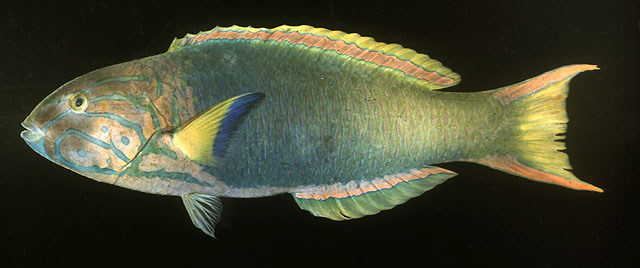| Labridae (Wrasses), subfamily: Corinae |
| 30 cm TL (male/unsexed) |
|
reef-associated; marine; depth range 0 - 30 m |
| Indo-Pacific: Sri Lanka to Ducie Island, north to southern Japan and the Hawaiian Islands, south to southeastern Australia, Lord Howe Island, the Kermadec Islands, and Rapa. Replaced by Thalassoma grammaticum in the tropical eastern Pacific (Ref. 37816). |
|
Dorsal spines (total): 8-8; Dorsal soft rays (total): 13-14; Anal spines: 3-3; Anal soft rays: 11-11. Body without longitudinal stripes. Initial phase body yellow with light vertical red lines. Terminal phase body abruptly blue to blue-green behind pink and green head. Reddish vertical lines on body. Pectoral fins yellow on basal half, blue to black distally (Ref 9823). |
| Occurs in groups (Ref. 90102) in clear outer lagoon and seaward reefs, over open sand and rubble as well as dense coral growth. Common is shallow exposed areas (Ref. 9710). Benthopelagic (Ref. 58302). Feeds mainly on shelled benthic invertebrates (crabs, shrimps, gastropods, bivalves, brittle stars, sea urchins), also on polychaete worms and fish eggs. Minimum depth reported taken from Ref. 128797. |
|
Least Concern (LC); Date assessed: 06 March 2009 Ref. (130435)
|
| harmless |
|
Known from Kimbe bay (Ref. 28888). |
Source and more info: www.fishbase.org. For personal, classroom, and other internal use only. Not for publication.

